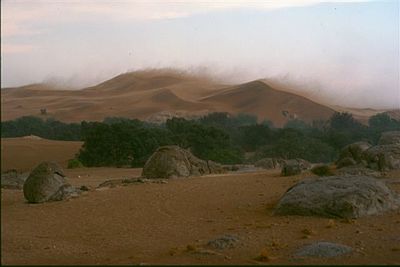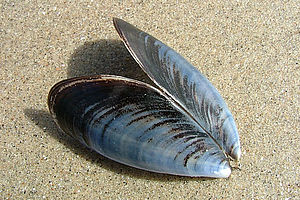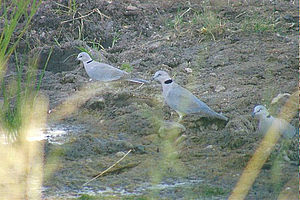Wind is air in motion. There is no wind on a frosty winter’s sunrise over the Khomas (‘hilly’) highlands of Namibia. Reaching over 2 000 metres into the atmosphere, this elevated plateau was uplifted hundreds of millions of years ago during the turbulent birth of Africa. It now forms deeply incised valleys and is where the coming wind of the day gains strength. Nurtured by high pressure cells formed over the Kalahari Desert far to the east, the wind begins to flow across the undulating mountain savanna. Hillsides, whose crop of silver grasses stood motionless under the chill of starlight, begin swaying in rhythm with the infant wind as it gains vigor, flowing westwards to the abrupt rim of the Kalahari Basin. Below the ragged lip of the escarpment lies the Namib Desert, still cold from the frequent fogs that are carried inland from the icy Benguela Current. As it descends the slopes, the wind undergoes a drastic transformation. Immutable laws of physics dictate that for every 100 metres it loses in altitude, it will gain 10C in heat. In addition, the scant wintry moisture it contains is sucked away until the air assumes a brittle, dehydrated quality. After a relentless descent of more than 2 000 metres, the altered wind arrives at the Namib coast, heated to a desiccating dryness of up to 400C. Coastal residents look up knowingly at the dust-laden skies and pronounce that the ‘Ostwind’ (East wind) has arrived. In this strangest of all coastal deserts, winter temperatures are often higher than the fog-drenched summers.
How does one define this invisible, essential agent of life that we call air? Held tightly against the Earth’s surface by gravity, our atmosphere delivers exactly the right balance of gases in the proportion of 78% nitrogen and 21% oxygen for us to live. Traces of other gases, infused with water vapour, constitute the remaining 1%. Unfortunately, one of them, carbon dioxide weighs heavily on the Earth and on our minds. This ubiquitous gas has reached levels that make prominent scientists refer to the ‘crashing climate’. An ominous warning about the 7 Gigatonnes (seven thousand million tonnes) that our industries, aircraft, automobiles and homes spew into the air every year came from the International Energy Agency, Washington DC in 2006. It reminds us that climate change isn’t some vague future problem – it’s already damaging the planet at an alarming rate’. Based on indisputable research, we are informed that Earth’s surface temperatures are most likely the warmest they have been in the past one million years. Humans have not before lived in a world this warm…..and we simply do not know, because we’ve never been there before, what the ‘tipping point’ is. When the environmental decay we are causing gives way to sudden and self-perpetuating collapse of ecosystems, we will know…..but it will be too late. Pump sufficient carbon dioxide into the sky and it may behave similarly to the 100th degree Celsius, which suddenly turns hot water into steam. If the Antarctic ice were to melt, it holds enough water to raise sea levels more than 65 metres, according to the United States National Centre for Atmospheric Research in Colorado. The rare gases remaining have unusual names, derived from Greek, like argon (‘idle of work’), helium (‘from the Sun’), hydrogen (‘water-forming’) krypton (‘hidden’) and neon (‘new’).Spare a thought for the traces of ozone, which occur throughout our atmosphere. Named after the Greek word ozein, for the peculiar smell generated in lightning storms, it is produced by ultraviolet rays reacting with oxygen. This makes it an unstable combination of ‘super oxygen’ that magically filters out most of the Sun’s harmful ultraviolet rays. Ironically, we humans need them in tiny doses to produce vitamin D. Too little ultraviolet on our skins and our health declines; too much and we develop skin cancer – it is a fine balance. The atmosphere provides a protective screen against invisible, but potent solar winds, which speed 150 million kilometres from the Sun across the ether in less than 10 minutes. This incoming solar radiation has the naked energy to destroy all life on Earth. Our air shield has no abrupt cut-off. It thins and fades away imperceptibly into space. Nevertheless, if a person ascends above 100 kilometres, he or she is dubbed an astronaut. Below this altitude we remain mere aeronauts. The hazardous, heat-generating re-entry of spaceships becomes noticeable at 120 kilometres, but for general purposes the Karmen line at 100 kilometres altitude is frequently used as the starting point of space.
Strange as it may seem, air has a mass or weight (about 5,000 trillion tonnes in total), resulting in what we know as air pressure. The density or mass of air at sea level is about 1.2 kg per cubic metre. Nearly two-thirds of this is below the summit of Mount Everest and three-quarters lies beneath the intercontinental jet liners that ply the world’s skyways, 10 kilometres above sea level. In the rarified regions above this, we witness the ghostly effects of the Aurora Borealis or ‘Northern Lights’, displaying phantom-like curtains of gas in the heavens of the high latitudes. Within the 1000C range of extreme temperatures that have been measured on Earth, from minus 500 C to plus 500C, our planet has a livable but cool surface average of 140C. Indeed, it is this span of cold and heat that generates winds which have shaped, and will continue to shape, the planet’s surface by aeolian processes. Named after the mythological Greek God of the Wind Aeolus, particles like abrasive sand both erode and leave deposits. Moreover, frost and precipitation of fog, rain and hail persistently pockmark the surface.
As Earth enters an uncertain climatic future, we take with us the knowledge that we are living in the ‘third atmosphere’. The first two, formed more than 3 to 4 thousand million years ago, were so noxious that present life forms could not exist. If people persist, in their ignorance, to pollute the air, a fourth atmosphere will develop, erasing life as we know it. Fortunately, Namibia boasts one of the cleanest atmospheres in the world. Let us therefore hope that the clean, cold, air that pervades the wintry Namibian nights and the hot desert winds remain as pure as they presently are.










